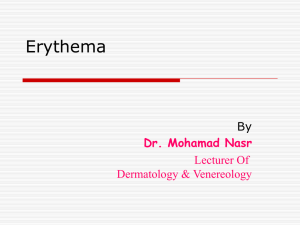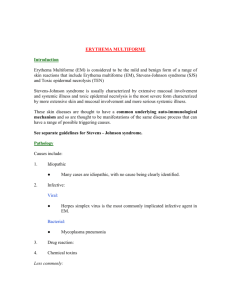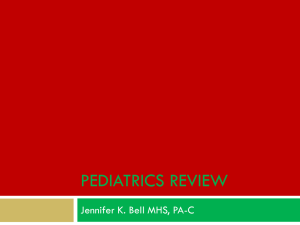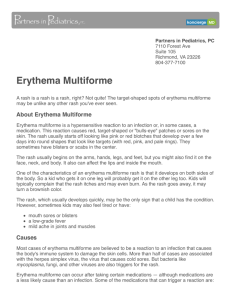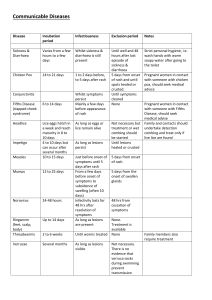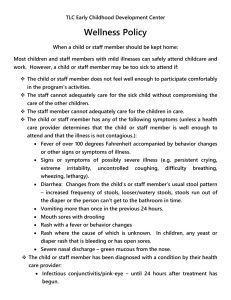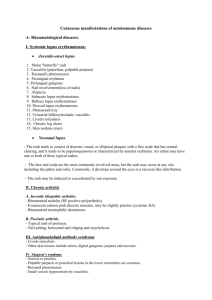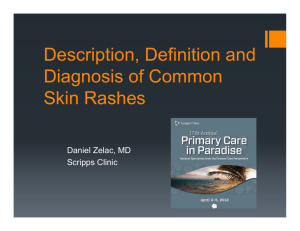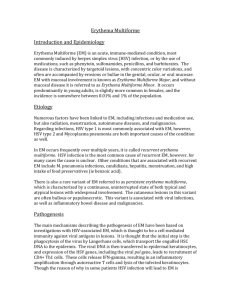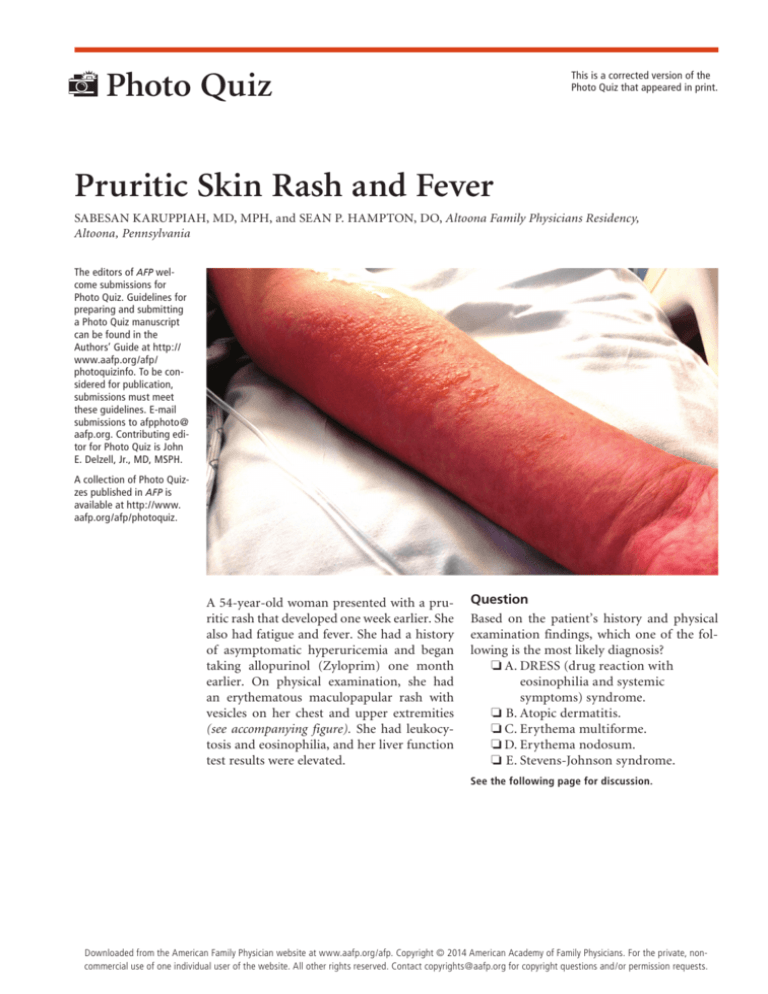
Photo Quiz
This is a corrected version of the
Photo Quiz that appeared in print.
Pruritic Skin Rash and Fever
SABESAN KARUPPIAH, MD, MPH, and SEAN P. HAMPTON, DO, Altoona Family Physicians Residency,
Altoona, Pennsylvania
The editors of AFP welcome submissions for
Photo Quiz. Guidelines for
preparing and submitting
a Photo Quiz manuscript
can be found in the
Authors’ Guide at http://
www.aafp.org/afp/
photoquizinfo. To be considered for publication,
submissions must meet
these guidelines. E-mail
submissions to afpphoto@
aafp.org. Contributing editor for Photo Quiz is John
E. Delzell, Jr., MD, MSPH.
A collection of Photo Quizzes published in AFP is
available at http://www.
aafp.org/afp/photoquiz.
A 54-year-old woman presented with a pruritic rash that developed one week earlier. She
also had fatigue and fever. She had a history
of asymptomatic hyperuricemia and began
taking allopurinol (Zyloprim) one month
earlier. On physical examination, she had
an erythematous maculopapular rash with
vesicles on her chest and upper extremities
(see accompanying figure). She had leukocytosis and eosinophilia, and her liver function
test results were elevated.
Question
Based on the patient’s history and physical
examination findings, which one of the following is the most likely diagnosis?
❏ A. DRESS (drug reaction with
eosinophilia and systemic
symptoms) syndrome.
❏ B. Atopic dermatitis.
❏ C. Erythema multiforme.
❏ D. Erythema nodosum.
❏ E. Stevens-Johnson syndrome.
See the following page for discussion.
February
1, 2014
Volume
89,Family
Number
3 website at www.aafp.org/afp.
www.aafp.org/afp
American
Family
Physician
Downloaded
from ◆the
American
Physician
Copyright © 2014 American Academy of Family
Physicians.
For the
private, 213
non­
commercial use of one individual user of the website. All other rights reserved. Contact copyrights@aafp.org for copyright questions and/or permission requests.
Photo Quiz
Discussion
The correct answer is A: DRESS (drug reaction
with eosinophilia and systemic symptoms)
syndrome, also known as anticonvulsant
hypersensitivy syndrome. This syndrome is
a medication-induced complex of symptoms
consisting of fever, pruritic rash, lymphadenopathy, and internal organ involvement.
It is associated with several anticonvulsant
medications, as well as allopurinol, sulfonamides, and other medications.1 Laboratory
abnormalities include hepatitis with leukocytosis and eosinophilia.2 Patients usually have
a macular or papular rash or erythroderma;
pustules are rare.2 Management includes discontinuing the offending agent and initiating
supportive systemic steroids.
Atopic dermatitis is a chronic inflammation of the skin that is common in children.
It is characterized by pruritus, and exacerbations and remissions. Patients develop
thickened skin, increased skin markings
(lichenification), and excoriated papules.
Diagnosis relies on a history of exposure to
certain irritants or allergens.3
Erythema multiforme is a relatively common, acute, self-limited, and sometimes
recurrent inflammatory disease. Herpes
simplex virus infection is the most commonly identified precipitant, followed by
Epstein-Barr virus infection,4 but erythema
multiforme can also be a reaction to medication. Symmetric, erythematous, target- or
iris-like papules and vesiculobullous eruptions appear on the extremities, palmar
surfaces, and plantar surfaces within days of
exposure.4 Mucosal lesions may occur in up
to 70% of cases, often on the lips and buccal
mucosa.2
Erythema nodusum is a nodular erythematous eruption usually limited to the
extensor aspects of the extremities. The
characteristic lesions begin as red, node-like
swellings over the shins, and commonly
affect both legs.2 Sulfonamides, bromides,
and oral contraceptives have been reported
to cause erythema nodusum.2 It is also
associated with streptococcal infections and
some cancers, such as lymphoma.
Stevens-Johnson syndrome is a severe
idiosyncratic reaction, most commonly triggered by medications, and is characterized
by fever and mucocutaneous lesions leading
to necrosis and sloughing of the epidermis.
Oral lesions such as mucosal blistering may
precede skin lesions. The skin lesions are
flat, atypical target lesions characterized by
blisters or purpuric macules.5
Address correspondence to Sabesan Karuppiah, MD,
MPH, at SKaruppiah@AltoonaFP.org. Reprints are not
available from the authors.
Author disclosure: No relevant financial affiliations.
Summary Table
REFERENCES
Condition
Characteristics
DRESS (drug reaction
with eosinophilia and
systemic symptoms)
syndrome
Medication-induced complex of symptoms
consisting of fever, pruritic rash,
lymphadenopathy, and internal organ
involvement; rash appears as papules or
erythroderma
Thickened skin and lichenification; excoriated
and fibrotic papules
Infection is the most common etiology; target
lesions with three color zones
Usually limited to the extensor aspects of the
extremities; nodular, erythematous eruption
Characterized by fever; most commonly caused
by medications; mucocutaneous lesions;
necrosis and sloughing of the epidermis
Atopic dermatitis
Erythema multiforme
Erythema nodosum
Stevens-Johnson
syndrome
214 American Family Physician
www.aafp.org/afp
1.Habif TP, Binnick AN, Meyerson LB, eds. Clinical Dermatology: A Color Guide to Diagnosis and Treatment. 5th
ed. St. Louis, Mo.: Mosby Elsevier; 2011.
2.Skonicki JJ, Warnock JK. Drug eruptions: 6 dangerous
rashes. Curr Psychiatr. 2008;7(4):101-109.
3.Correale CE, Walker C, Murphy L, Craig TJ. Atopic dermatitis: a review of diagnosis and treatment. Am Fam
Physician. 1999;60(4):1191-1198.
4.Huff JC, Weston WL, Tonnesen MG. Erythema multiforme: a critical review of characteristics, diagnostic criteria, and causes. J Am Acad Dermatol.
1983;8(6):763-775.
5.Nirken MH, High WA. Stevens-Johnson syndrome
and toxic epidermal necrolysis: clinical manifestations;
pathogenesis; and diagnosis. UpToDate. http://www.
uptodate.com /contents/stevens-johnson-syndromeand-toxic-epidermal-necrolysis-clinical-manifestationspathogenesis-and-diagnosis (subscription required).
Accessed November 13, 2013. ■
Volume 89, Number 3
◆
February 1, 2014

